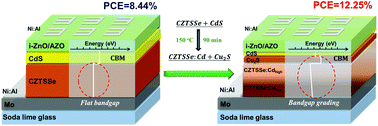Band-gap-graded Cu2ZnSn(S,Se)4 drives highly efficient solar cells†
Abstract
Fabrication of highly efficient solar cells is critical for photovoltaic applications. A bandgap-graded absorber layer can not only drive efficient carrier collection but also improve the light harvesting. However, it is very difficult to realize such a bandgap-graded structure in kesterite-structured films due to the similar cation diffusion rates in the high-temperature selenization process. Here, we design and successfully realize a bandgap grade in Cu2ZnSn(S,Se)4 (CZTSSe) film by sufficient annealing during the deposition of an Al-doped ZnO film. This annealing strategy facilitates the solid-state ion-exchange reaction between Cu+ and Cd2+ at the heterojunction interface. Consequently, n-type CdS is partially converted to p-type Cu2S and CZTSSe is converted to Cd-graded CZTSSe, thereby forming a desired bandgap-graded CZTSSe solar cell. The tailored band alignment between the p–n junction not only improves the electron transport but also reduces the carriers recombination. As a consequence, the open-circuit voltage and fill factor are significantly improved, and a certified power conversion efficiency of 12.25% is obtained. The graded bandgap engineering of the absorber achieved here illuminates the future pathway towards highly efficient solar cells.

- This article is part of the themed collection: EES symposium collection


 Please wait while we load your content...
Please wait while we load your content...